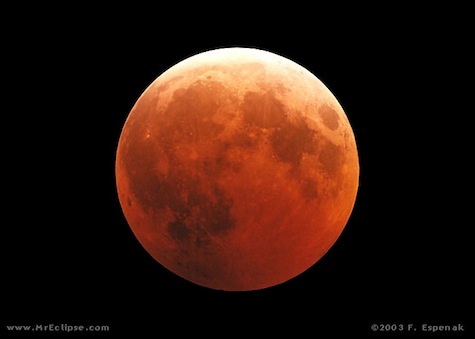
According to National Geographic, scientists suspect that volcanic ash from Iceland may have colored our moon a pale red this past Saturday during an eclipse. While not a total eclipse, the show in the sky began at dawn in North America, in the central and western part, that is. Those of us on the East Coast definitely missed out.
Astronomer Geza Gyuk at the Adler Planetarium in Chicago explained the science behind the phenomenon, “While I haven’t heard of reports of particularly fantastic sunsets occurring because of the Icelandic volcano, it might be quite pretty if the ash in the air causes an extra reddening of the light reaching the moon.”
Judging from the pictures, the red moon wasn’t quite as splendid as advertised, but still rather beautiful.
The red lunar eclipse, however, is just one among many intriguing phases of the moon. For those among you who are curious, here’s a few lunar terms explained:
Blue Moon – A common misconception is that a blue moon refers to color (which sometimes does occur; see the Tyndall Effect below). In actuality, a blue moon is simply a month wherein there are two full moons (more commonly understood these days) or, a season in which there is a fourth moon (rather than three).
Tyndall Effect – There have been occurrences of truly blue moons in the past, but the instances are rare. More often than not–just like the red moon–it’s because of particles in the air, most frequently due to volcanic events around the globe, or, in some cases, large forest fires. According to Wikipedia, the blue color we see is due to particles “slightly wider than the wavelength of red light (0.7 micrometre)… [with] no other sizes present.”
Wet Moon – I’d never heard of this term, but I’ve seen it many times. A Wet Moon is when the moon is, as I think of it anyway, in the Cheshire Cat position–both horns pointing up. The term comes from Hawaiian myth, which held that the moon looked like a bowl, ready to be filled with water, and portended rain to come.
Harvest Moon – The Harvest Moon is the closest full moon to the autumnal equinox, and often makes quite a statement in the sky. Due to the tilt of the earth at that time of year, it can appear significantly larger than normal, hanging low on the horizon, and can even be a deep orange color. As Wikipedia explains:
The warm color of the moon shortly after it rises is caused by light from the moon passing through a greater amount of atmospheric particles than when the moon is overhead. The atmosphere scatters the bluish component of moonlight (which is really reflected white light from the sun), but allows the reddish component of the light to travel a straighter path to one’s eyes.
Hunter’s Moon – The first full moon after the Harvest Moon. It’s called the Hunter’s Moon because it means bright nights, ideal for hunters looking for more time and better lighting during the hunt. Both Native Americans and Western Europeans are known to have held feasts celebrating the Hunter’s Moon, and with good reason. It was likely quite a cause to celebrate.
(via Wikipedia, National Geographic; image in the public domain from NASA)
